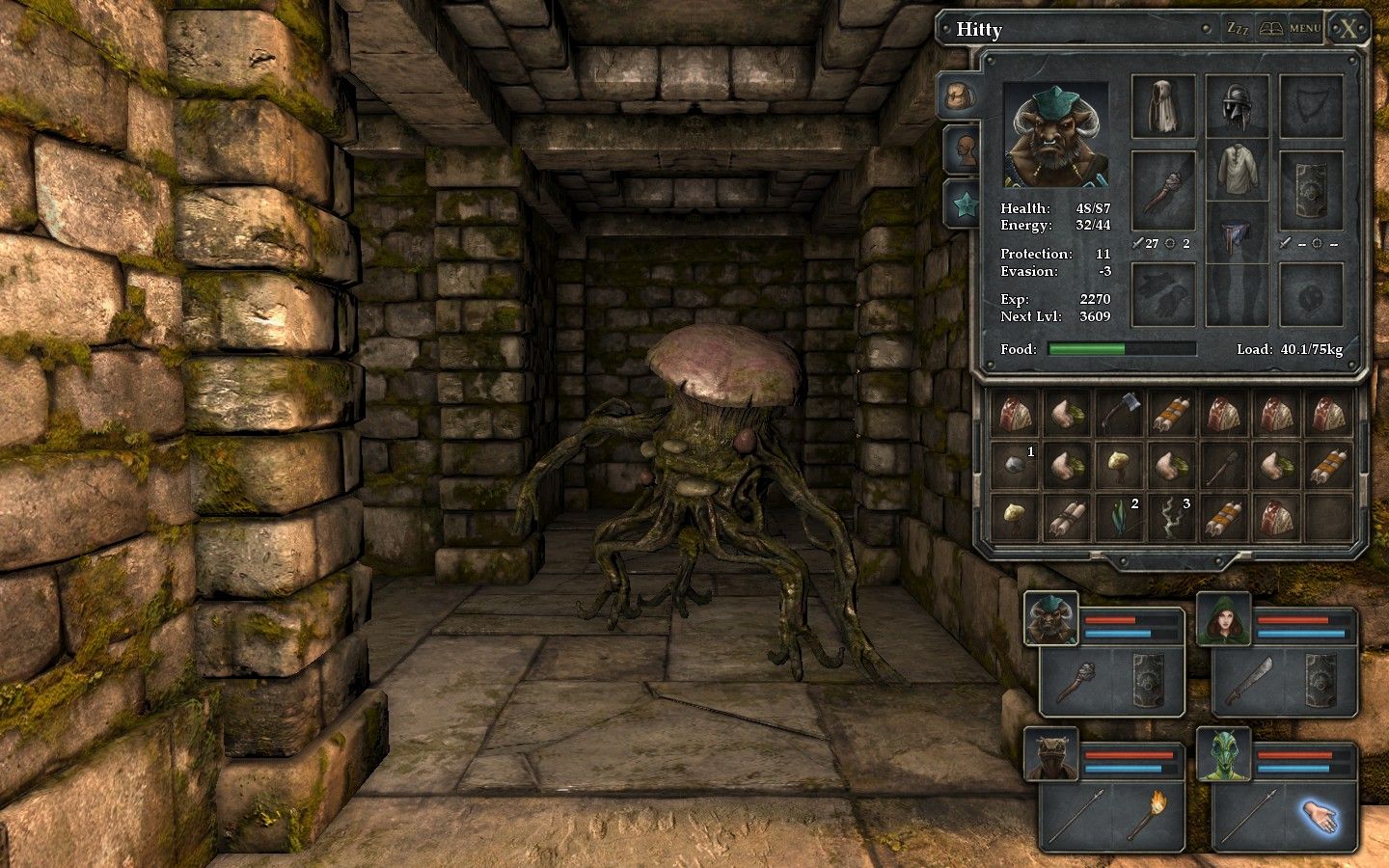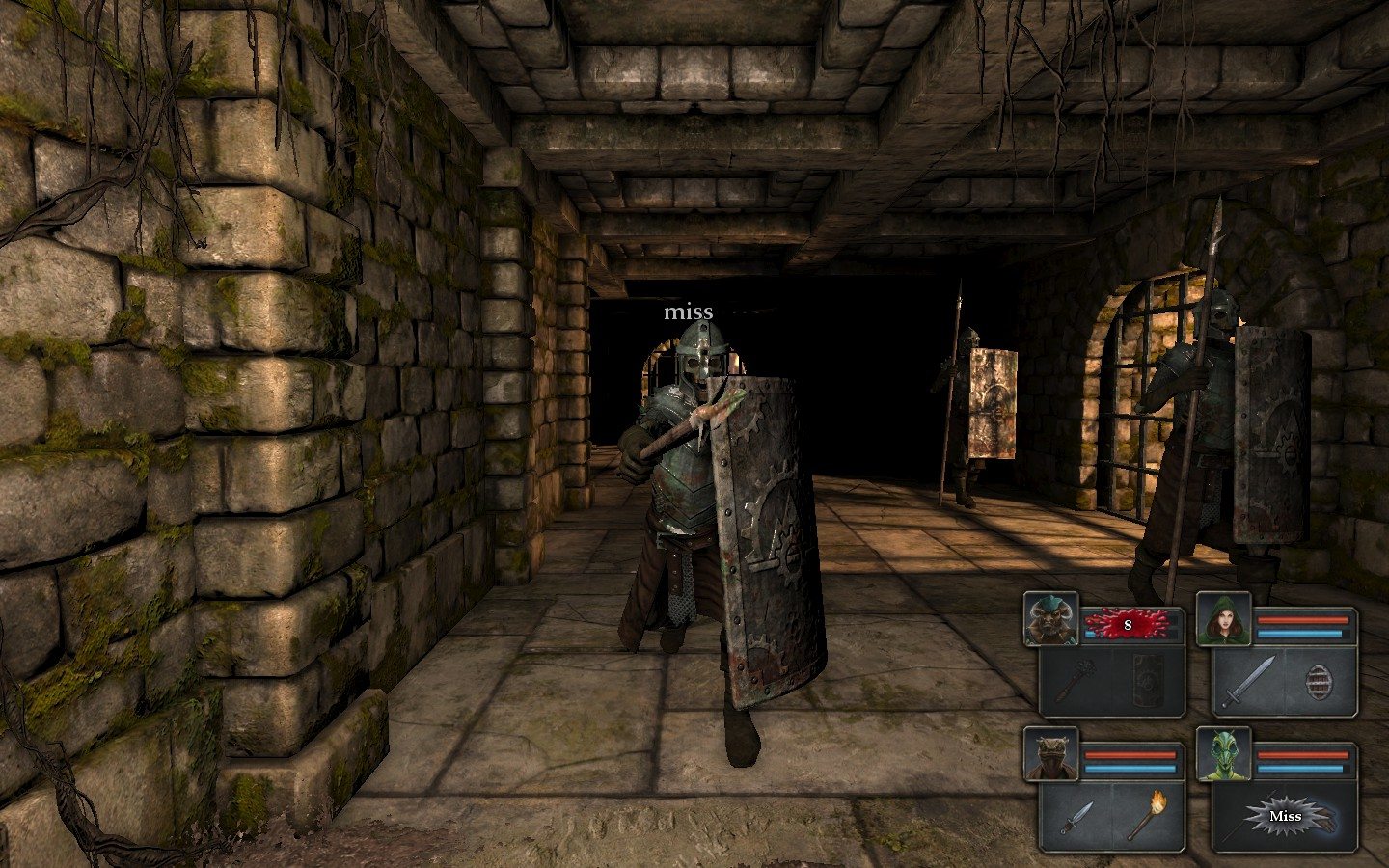Despite my old-school Atari/Amiga background I never played Dungeon Master – I think the closest I ever got was the actually-not-that-bad Knightmare – and so while I was familiar with the theory of how the first-person dungeon crawling genre worked, I had very little experience of it in practice. I wasn’t quite sure how Grimrock would play, and I wasn’t sure how much the developers would have tinkered with the mechanics in order to make it palatable to our modern gaming tastes. Turns out I needn’t have worried; Legend of Grimrock is incredibly old school in tone even if some of the fine detail has had a fresh coat of paint plastered on top, and it’s all the better for it.
You! Are a party of four adventurers, dumped into a dungeon with nothing except the clothes on their backs. The four adventurers evidently have military training – perhaps they are the fantasy equivalent of the A-Team, sentenced to prison for crimes they did not commit – because they move around the dungeon in a fixed rigid two by two formation; two in the front row, two in the back row, moving and strafing and wheeling on the spot like a well-drilled machine. (That is, they are so proficient at drill they move like a machine, not that they are a machine for drilling wells.) The dungeon is divided into square tiles and your party explores it one tile at a time with you providing directions via traditional WSAD controls, as well as Q and E for turning.
Crucially, I think, your perspective never changes. You never see your party members beyond a set of portraits at the bottom of the screen and the obligatory paper doll in the inventory, and this helped my suspension of disbelief over the movement mechanic and dungeon layout a great deal. Towards the end a dungeon made up of squares where you can only move in one of the four cardinal directions almost begins to seem natural, in a way. Despite being deliberately and consciously artificial Grimrock is actually one of the most immersive RPGs I’ve ever played, and this is down to both the fixed first-person view of the environment and the way you interact with that environment.
Say you come across a button and you want to press it. You do not “Press E to push button!” as so many modern RPGs would have you do; instead, you actually physically push the button with your mouse pointer. If there’s a pressure plate on the other side of a pit that you want to trip you can simply drag a rock out of your inventory and over the top half of the screen, and then click to (hopefully) throw it so that it’ll land on the plate. You can’t throw things through metal gratings, but you can poke items through the holes at the bottom as well as picking up stuff that’s immediately on the other side. In other words, even though Grimrock doesn’t have any fancy real-world physics system it still manages to create a more convincing facsimile of real-world interactions than a thousand Trines could ever manage.
This has particular ramifications for the amount of latitude it’s given the developers when designing Grimrock’s puzzles. It’s amazing how much variety they managed to squeeze out of pits, pressure plates and teleporters, but there’s at least one fiendish head-scratcher on every level bar the first which can take anywhere from between five to fifteen minutes to figure out. Often figuring out what you have to do is only half the battle; it’s how you’re supposed to do it that requires the mental quantum leap. Like all the best puzzlers Grimrock is tricky but not impossible and makes the player feel a lot smarter than they actually are when they solve something. This goes double for the secrets, which are often revealed by carrying out an additional hidden step during a puzzle like tripping a button on the wall while running pell-mell over collapsing floor plates.
Grimrock is at its best when puzzling, which fits in well with the dungeon crawling setup – after all, what is a dungeon without puzzles that aren’t the Towers of Hanoi? There’s a couple of puzzles which possibly aren’t pitched all that well – there was one where I had to piece together a series of phrases that gave me difficulty because they were worded a bit strangely – but on the whole they’re excellent. By contrast, Grimrock is at its absolute worst when a monster appears on the horizon, since that means you’ll then have to fight it.
At first glance the combat mechanic is fairly decent. The party being divided into front and back rows is very important; without special weapons or abilities the party members in the front row are the only ones that can hit monsters in melee, but they’re also the only ones who can be hit by a monster attacking from the front (monsters attacking from the side or rear can hit your back row, which tends to result in one-shot kills). Hence the front row will invariably consist of two heavily armoured fighters to soak up all the damage. The back row is where you put your rogues and mages since they have all the ranged attacks. Fighting monsters can be a rather hectic affair where you frantically make attacks and cast spells with one hand while mixing healing potions and antivenom with the other hand. This only happens if you get cornered and can’t move, though, because there’s two factors at work that kind of sabotage the combat in Grimrock. The first is that the party can move faster than most monsters can turn, meaning the best tactic is one where you constantly circle an enemy and hit it in the side or rear where it can’t retaliate. The second is that the monsters all have buckets of health and hit like trucks, making a toe-to-toe confrontation with more than one completely suicidal.
By level three or so I’d figured this out, and so after this point the combat got a bit samey: if I was in a narrow one-tile width corridor I’d hit and retreat, hit and retreat, never letting my opponent get close enough to strike back. If I had some room to maneuver I’d do the safety dance, always making sure I was on a diagonal, hitting the monster as it moved into a space adjacent to me and then nimbly skipping away to another diagonal. It’s something that requires constant movement and awareness of your surroundings, but what it isn’t is particularly deep or complex. Hit something for long enough and it will eventually go down. It just takes a while, is all.
To their credit the developers try to keep things interesting by continually introducing new monster types, some of which are fast enough that the safety dance doesn’t work (fucking spiders), and some of which have ranged attacks. It’s only a matter of time before you figure out the best way to take them down, though, at which point fighting them becomes routine. I’m not going to call the combat in Grimrock bad as such, it’s just not particularly demanding and the one part of the game which doesn’t really live up to its potential.
Still, it doesn’t mar what it otherwise a fantastic achievement. Grimrock is a very well-designed game that constantly keeps you on your toes until the final level; I wouldn’t be surprised if it’s the most intellectually demanding game I play this year. Lengthwise it’s fairly well pitched, taking me about eleven hours to finish – long enough that I felt like I got my money’s worth, and short enough that the game never ran out of imagination. The non-random nature of the game means replay value may be a little lacking – although I’m sure I’ll go back in a year or two – but the developers will hopefully release more adventures using the engine as well as a set of tools that allow players to create their own. It’s definitely a genre with a lot of potential, and one which couldn’t ask for a better trailblazer than Grimrock, a game which really showcases what dungeon crawlers can do at their best. More like this, please.





+1. As it were.
I thoroughly enjoyed this and my experience was much like yours. I think the puzzles and the secrets (OH SO MANY SECRETS) were definitely the highlight and kept me going, exploring, puzzling over levers and experimentally jumping down pits.
I didn’t really have trouble with the combat in terms of being routine. It was perfectly functional and it kept you on your toes, even if you knew what you needed to do.
I think the biggest deficiency for me was the lack of skill-points and spells. Few-ish skill-points didn’t let me explore too many of my party’s skills and the spells were basically just the 4 or so with elemental variations and a couple of random ones. Would have been nice to see something a little more elaborate.
I also really really liked the boss fight. As far as boss fights go when they need to be included this has been by far the best one for years.
What I really really want now is a modern and good Might and Magic. Yes please.
I just DL’ed this one – my co-hosts on LDG are all over this one… time I hunkered out to check it out myself
[...] but that all happened early on and the game looks the same to me now as it did back in 2002. Grimrock proved there was still a huge appetite for old-school dungeon crawlers, so why don’t we resurrect [...]
Great review! I loved Dungeon Master back in the day and I was enthusiastic over the prospect of Grimrock. I left off a couple of hours into it with the same gripe that you have: the dominant strategy of the safety dance combat just wasn’t very enjoyable for me.
I’m curious now as to whether DM had a better approach, despite the mechanics being 99% similar at first glance, or whether it was just such a groundbreaking game that I either didn’t notice or didn’t mind. I think there wasn’t anything notably different except maybe more confined corridors with limited room. Safety dance was still possible, but more like safety retreat: I’m vaguely remembering these long retreating battles where I’d wait for the monsters to move toward me and then I’d attack & quickly back away another step.
Brainstorming now, seems like some good options would be to have a “disengage penalty” of some sort – either the monster gets a free attack as you leave or you take a big endurance hit; something that makes standing your ground a strong option.
You mentioned how cool it was to be able to literally press buttons and throw rocks onto pressure plates, etc. DM also had those things (plus nice puzzles as well) and it was so novel and magical! I suspect DM was the first “object-based” game where every item in the game was an object that could be directly manipulated, moved, dropped, etc. I can’t remember how deaths work in Grimrock, but in DM when a party member died, all their inventory would appear in a single pile on top of a set of bones. You had to quickly play Towers of Hanoi to shift all their items out of the way, grab their bones, backtrack to the nearest resurrection altar, and put their bones in the altar to get them back again. Then go pick up all their stuff again haha!